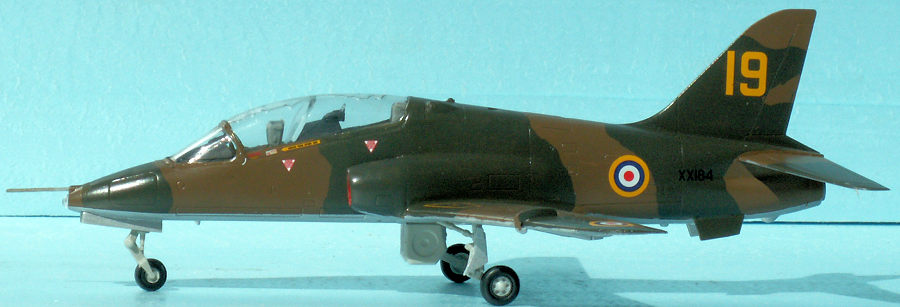
Airfix 1/72 Hawk T.1A
| KIT #: | A73000 |
| PRICE: | @$15.00 |
| DECALS: | Two options |
| REVIEWER: | Torben Plesberg |
| NOTES: | Airfix Club edition. |

| HISTORY |
The Hawk is a well-known aircraft type thanks to the famous aerobatic team “The Red Arrows”. The Hawk was the successor to the former aerobatic aircraft of the Red Arrows: the Folland Gnat. Actually, the Hawk was designed to succeed the Folland Gnat as a fast jet trainer. Like the Gnat, the Hawk is a tandem two seat trainer with combat capability. The latter was important, improving the export sales potential. The Hawk project was approved by 1970, and, a contract for 175 aircraft for the RAF was signed in 1972, and the first aircraft flew in August 1974.
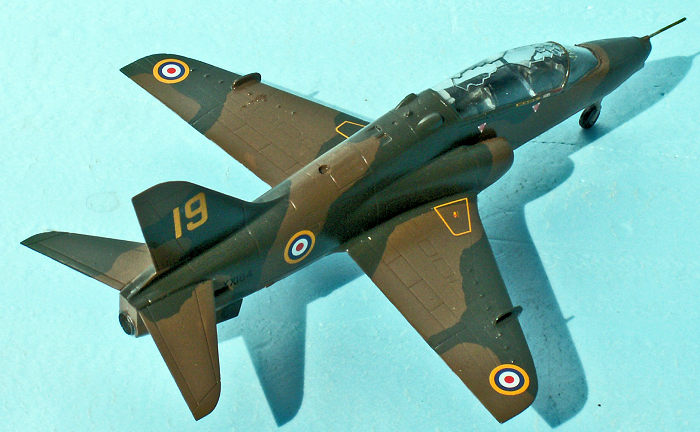 The Hawk is a conventional low
wing aircraft with a slightly swept wing and powered by a turbofan engine with
air intakes in the wing roots. The main landing gear has a wide track, and the
nose gear is retracting forwards into the nose. The internal fuel capacity is
1650 l, enough for 3 hours of operation.
The Hawk is a conventional low
wing aircraft with a slightly swept wing and powered by a turbofan engine with
air intakes in the wing roots. The main landing gear has a wide track, and the
nose gear is retracting forwards into the nose. The internal fuel capacity is
1650 l, enough for 3 hours of operation.
The Hawk is very manoeuvrable as one would expect for a trainer – and especially as the aircraft for the Red Arrows. The top speed is Mach 0.88 in level flight and Mach 1.15 in a dive. The Hawk is designed to carry a centerline gun pod housing a 30 mm Aden cannon, and it has two underwing hard points for pylons to carry bombs or missiles.
The Hawk entered RAF service in 1976 replacing Gnats and Hunters in the advanced training and weapon training roles. The following units flew the Hawk: No 4 Flying Training School no 19 and 208 sqd, no 100 sqd, the Red Arrows and a couple of other units. Some past units were: sqd 74, 79, 234, 63, 151 and 92. The Royal Navy uses the Hawk T. 1 with FRADU at RNAS Culdrose.
Sqd 19 celebrated its 70th anniversary by painting a Hawk in the same camouflage scheme as worn by the first Spitfire delivered to the squadron in August 1938. This project was carried out between Friday 11 April 2008 and Thursday 1st May 2008. The “Spithawk” took to the air from RAF Valley piloted by wing commander Hill and crewed by Flt. Lt. Paddy Ireland. This aircraft is the subject of my model, and one of the two options of the kit.
The Hawk was a great success with the RAF, and with the air forces of many other countries, too, among these Australia, Canada, India, Indonesia, Finland and Switzerland. The Finnish Air Force, Ilmavoimat, operates 75 Hawks and has an aerobatic team with four aircraft, the “Midnight Hawks”.
| THE KIT |
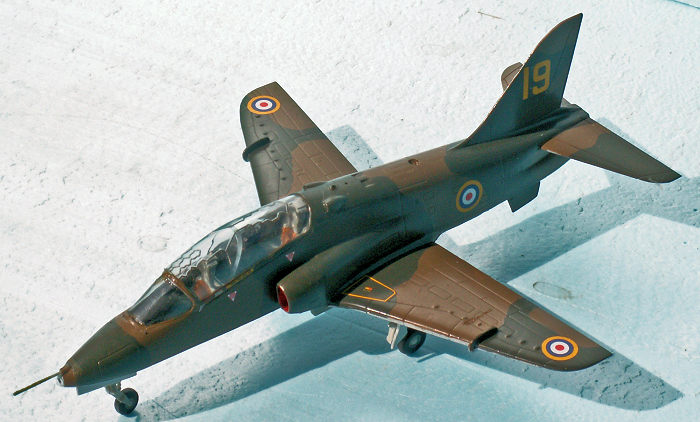 The kit comes in a small
sturdy box, which opens normally and can be used as a base for the construction.
There are 4 sprues in a pale blue styrene and a clear sprue with the transparent
parts. The instructions is a folded sheet making an A5 leaflet. Page one shows
general assembly instructions in 12 languages and also icon instructions. The
paint references are as expected for Humbrol colors. Page two to six show in 19
steps how to assemble the model and paint the details. There is a single color
printed extra sheet showing the color schemes and decaling of the two options of
the kit. On the rear side of this sheet there is a complete guide to the
positioning of stencils and illustrated by a four view drawing. The decal sheet
is comprehensive and of good printing quality. The decals are easy to apply and
the thickness of the carrying film is just right. However, there are no
instrument panels on the decal sheet, even if the instructions suggests there
are!
The kit comes in a small
sturdy box, which opens normally and can be used as a base for the construction.
There are 4 sprues in a pale blue styrene and a clear sprue with the transparent
parts. The instructions is a folded sheet making an A5 leaflet. Page one shows
general assembly instructions in 12 languages and also icon instructions. The
paint references are as expected for Humbrol colors. Page two to six show in 19
steps how to assemble the model and paint the details. There is a single color
printed extra sheet showing the color schemes and decaling of the two options of
the kit. On the rear side of this sheet there is a complete guide to the
positioning of stencils and illustrated by a four view drawing. The decal sheet
is comprehensive and of good printing quality. The decals are easy to apply and
the thickness of the carrying film is just right. However, there are no
instrument panels on the decal sheet, even if the instructions suggests there
are!
| CONSTRUCTION |
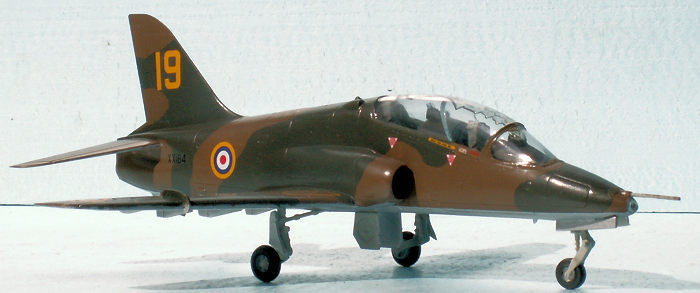 If you follow the instructions,
you will end up with a nice and precise model of a Hawk T. 1. However, I shall
comment some of the steps:
If you follow the instructions,
you will end up with a nice and precise model of a Hawk T. 1. However, I shall
comment some of the steps:
Step 1 + 3: I did not assemble the pilot and put him into his seat. Often, the pilot figure is too big, and there is simply not room enough for him in his seat. No need to have this problem! Part no 9 A is too tall, and it is necessary to sand 1 mm off the top. Otherwise, part no 14 A (step 12) cannot be glued in place.
Step 4: The Hawk is a born tail sitter, and needs in the least 5 g of lead in the nose, that is in the well of the nose wheel. Part 6 B – the exhaust pipe of the engine – is far too clumsy. A spent cal. 0.22 cartridge will do the job much better!
Steps 5 + 6: It is a good thing to paint these parts before the assembly. Otherwise, it will be almost impossible.
Step 9: It is important to make the suggested cuts before the assembly of the wing. It is very difficult to do on an assembled wing.
Step 10: It is a good idea to make some small slots in the wings for the fences – parts 17 B + 18 B.
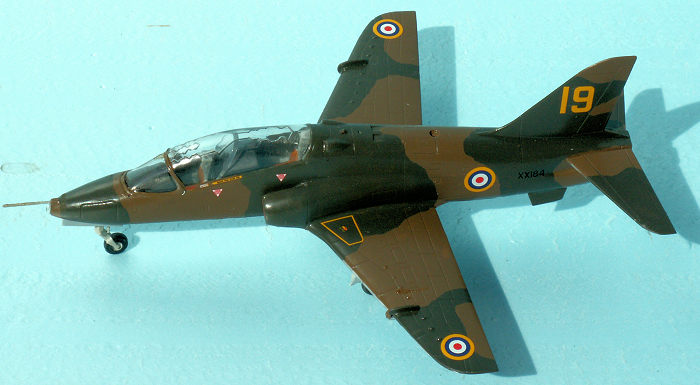 Step 11: The six hinges for the
landing flap must be sanded to fit properly into the small slots in the wing.
Step 11: The six hinges for the
landing flap must be sanded to fit properly into the small slots in the wing.
Step 12: The arrow pointing upwards from part 4 H to the inner side of part 6 H is a bad advice. It is much easier to glue the transparent part 4 H to the oblique front of part no 13 A. The arrow should point downwards to the front of part 13 A. The anhedral of 10 degrees of the tail planes is clearly shown in the insert.
Step 18+19: Parts 3 D+4 D are supposed to be a 30 mm gun pod. However, where is the gun barrel? I chose to omit this part, because it is not correct. It might be a “fake” gun pod? I guess it is a “smoke” pod with the Red Arrows.
The steps not mentioned caused no problems at all to me.
| COLORS & MARKINGS |
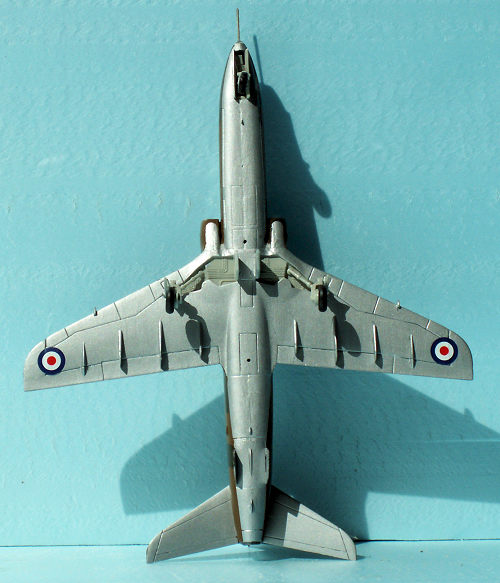 The standard color scheme of a
Spitfire of sqd 19 in 1938 was a camouflage pattern on the upper sides,
consisting of dark earth, HB 29, and dark green, HB 163. The undersides were
bare metal, aluminum HB 56 or 27001 polished aluminum. The same color scheme was
applied for the anniversary Spithawk. The decals are of first class quality,
well printed and easy to apply. The second option of the decal sheet offers
another anniversary color scheme, namely to mark the 90th anniversary of the
Royal Air Force Benevolent Fund. These decals are for an all black Hawk.
The standard color scheme of a
Spitfire of sqd 19 in 1938 was a camouflage pattern on the upper sides,
consisting of dark earth, HB 29, and dark green, HB 163. The undersides were
bare metal, aluminum HB 56 or 27001 polished aluminum. The same color scheme was
applied for the anniversary Spithawk. The decals are of first class quality,
well printed and easy to apply. The second option of the decal sheet offers
another anniversary color scheme, namely to mark the 90th anniversary of the
Royal Air Force Benevolent Fund. These decals are for an all black Hawk.
| CONCLUSIONS |
This Airfix Club Limited Edition 1/72 Hawk T. 1 with the decal sheet of Model Alliance offers two refreshing alternatives to a standard Flying School Hawk and a Red Arrows Hawk. The kit is definitely a good one, and it is recommendable to all modelers, who fancy jet trainers and especially the BAE Hawk.
| REFERENCES |
www.airfix.com pages 8-9 from the Airfix Club Magasine issue 4 dealing with the painting of the Spithawk in 2008, and pages 10-11 dealing with the building, painting and decaling of a Hawk model in scale 1/48, which was donated to the Valley Aviation Society in conjunction with the anniversary.
Wikipedia article: BAE Hawk
15 February 2021
Copyright Modeling Madness.com. All rights reserved.
If you would like your product reviewed fairly and fairly quickly, please contact the editor or see other details in the Note to Contributors.
Back to the Main Page Back to the Review Index Page Back to the Previews Index Page